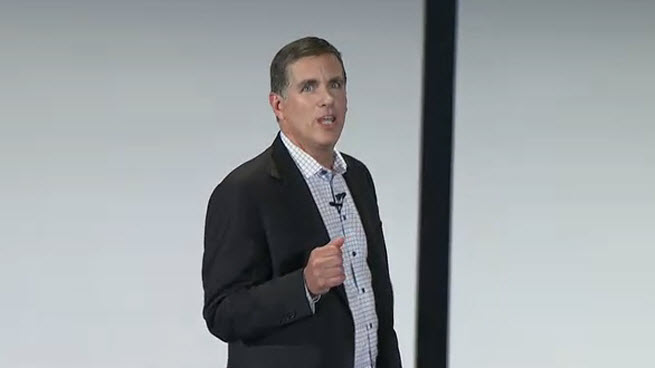Intel showed off its next-generation tablet and smartphone processors today at the Computex computer trade show in Taiwan.
[aditude-amp id="flyingcarpet" targeting='{"env":"staging","page_type":"article","post_id":749492,"post_type":"story","post_chan":"none","tags":null,"ai":false,"category":"none","all_categories":"business,mobile,","session":"A"}']“We believe this is a 2-in-1 era,” Kilroy said in his speech, referring to devices that can be converted into laptops or tablets.
AI Weekly
The must-read newsletter for AI and Big Data industry written by Khari Johnson, Kyle Wiggers, and Seth Colaner.
Included with VentureBeat Insider and VentureBeat VIP memberships.
Later this year, Intel will unveil the Silvermont microarchitecture for future Atom microprocessors, which are targeted at low power devices. The Bay Trail version of Silvermont will be used in tablets this holiday, Avoton will be used in microservers, and Merrifield will be used in smartphones. Silvermont promises three times more performance and five times lower power compared to the current Intel Atom processors. Bay Trail will support high-performance mobile computing and deliver more than 8 hours of battery life.
“Today we deliver on the vision set forth 2 years ago to reinvent the laptop with the introduction of our 4th generation Intel Core processors that were designed from the ground up for the Ultrabook and serve as the foundation for a new era of 2-in-1 computing,” said Kilroy. “We made one of the most seismic changes to our roadmap ever to build these new Core processors that deliver the stunning performance of the PC and the mobility of a tablet in one device. The new processors power the most exciting 2-in-1 designs to-date.”
Intel showed Bay Trailer working in a tablet with a 4G LTE multimode data networking solution. Intel said that the Intel XMM 7160 4G LTE multimode solution will support global LTE roaming in a single product.
The codenamed Bay Trail will be a quad-core chip built with a 22-nanometer manufacturing process. It will be used in x86-based tablets that can run Microsoft’s Windows 8 operating system. Bay Trail will offer twice the performance of the Clover Trail processors introduced for tablets last fall. The Bay Trail chips will also have lower power consumption. That means we’ll see tablets with longer battery lives, better performance, and thinner cases. Intel says Bay Trail tablets will be thinner than 0.3 inches.
“Bay Trail is optimized for Windows and Android tablets,” said Patrick Moorhead, an analyst at Moor Insights & Strategy. “While it doesn’t yet bring PC performance to a fanless tablet, it does provide higher-end consumer PC features to the tablet scene like DirectX11 graphics, intelligent overclocking with Intel Burst, and wireless display. For the enterprise market, Bay Trail is a slam-dunk over any of Apple’s solutions given x86 compatibility and PC-grade management, security, and deployment.”
[aditude-amp id="medium1" targeting='{"env":"staging","page_type":"article","post_id":749492,"post_type":"story","post_chan":"none","tags":null,"ai":false,"category":"none","all_categories":"business,mobile,","session":"A"}']
Meanwhile, Merrifield will be targeted at x86-based smartphones. Intel has made some progress getting into smartphones in the past year, but the sales volumes aren’t making a big difference on its bottom line yet. It also showed a working Merrifield design as part of a smartphone reference design, or a prototype that other Intel customers could use to build their own smartphones.
Merrifield will include an “integrated sensor hub” for personalized services. It will also have built-in data, device and privacy protection.
VentureBeat's mission is to be a digital town square for technical decision-makers to gain knowledge about transformative enterprise technology and transact. Learn More

